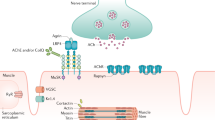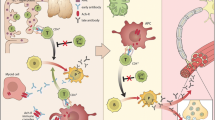Summary
Myasthenia gravis is an autoimmune disorder of neuromuscular transmission. It is characterised by muscular weakness and fatiguability. Extrinsic ocular muscles are frequently involved at the onset of the disease; in about 15% of cases clinical signs remain confined to these areas, while in the other patients weakness becomes generalised.
Diagnosis relies on clinical history and signs, improvement on anticholinesterase injection, electromyographic signs of impaired neuromuscular transmission and serum antiacetylcholine receptor (anti-AChR) antibody titration. Apart from the anti-AChR antibody assay, no single test is specific for myasthenia gravis; it is rather their combined results that can confirm diagnosis.
The therapeutic approach varies from patient to patient and, as far as possible, should be adapted to each individual. Symptomatic drugs such as anticholinesterases improve muscle strength but seldom restore it to normal. Immunosuppressive therapy is very effective but entails the risk of severe adverse effects. Thymectomy improves the course of the disease and can increase remission rate; short term treatments are of benefit in the management of myasthenic emergencies.
Similar content being viewed by others
References
Engel AG. Myasthenia gravis and myasthenic syndromes. Ann Neurol 1984; 16: 519–34
Evoli A, Tonali P, Bartoccioni E, et al. Ocular myasthenia gravis: diagnostic and therapeutic problems. Acta Neurol Scand 1988; 77: 31–5
Newsom-Davis J, Willcox N, Schluep M, et al. Immunologic heterogeneity and cellular mechanisms in myasthenia gravis. Ann NY Acad Sci 1987; 505: 12–26
Oosterhuis HJGH. Myasthenia gravis: clinical neurology and neurosurgery monographs. Edinburgh: Churchill Livingstone, 1984
Oh SJ, Cho HK. Edrophonium responsiveness not necessarily diagnostic of myasthenia gravis. Muscle Nerve 1990; 13: 187–91
Phillips LH, Melnick PA. Diagnosis of myasthenia gravis in the 1990s. Semin Neurol 1990; 10: 62–9
Howard JF, Sanders DB, Massey JM. The electrodiagnosis of myasthenia gravis and the Lambert-Eaton myasthenic syndrome. Neurol Clin 1994; 12(2): 305–30
Sanders DB, Howard JT. AAEE minimograph no. 25: single-fiber electromyography in myasthenia gravis. Muscle Nerve 1986; 9: 809–19
Lindstrom J. An assay for antibodies to human acetylcholine receptor in serum from patients with myasthenia gravis. Clin Immunol Immunopathol 1977; 7: 36–43
Vincent A, Newsom-Davis J. Acetylcholine receptor antibody as a diagnostic test for myasthenia gravis: results in 153 validated cases and 2967 diagnostic assays. J Neurol Neurosurg Psychiatry 1985; 48: 1246–52
Limburg PC, The TH, Hummel-Tappel E, et al. Anti-acetylcholine receptor antibodies in myasthenia gravis: pt 1. Relation to clinical parameters in 250 patients. J Neurol Sci 1983; 58: 357–70
Engel AG. Congenital myasthenic syndromes. Neurol Clin 1994; 12(2): 401–37
Vincent A, Li Z, Hart A, et al. Seronegative myasthenia gravis: evidence for plasma factor(s) interfering with acetylcholine receptor function. Ann NY Acad Sci 1993; 681: 529–38
Drachman DB. Myasthenia gravis. N Engl J Med 1994; 330: 1797–810
Sanders DB, Scoppetta C. The treatment of patients with myasthenia gravis. Neurol Clin 1994; 12(2): 343–68
Ricciardi R, Rossi B, Nicora M, et al. Acute treatment of myasthenia gravis with intranasal neostigmine: clinical and electromyographic evaluation. J Neurol Neurosurg Psychiatry 1991; 54: 1061–2
Abramsky O, Aharonov A, Teitelbaum D, et al. Myasthenia gravis and acetylcholine receptor: effect of steroids on clinical course and cellular immune response to AChR. Arch Neurol 1975; 32: 684–7
Tindall RSA. Humoral autoimmunity in myasthenia gravis: effects of steroids and thymectomy. Neurology 1980; 30: 554–7
Sommer N, Melms A, Weiler M, et al. Ocular myasthenia gravis: a critical review of clinical and pathophysiological aspects. Doc Ophtalm 1993; 84: 309–33
Haward CWH, Fonseca V. New treatment approaches to myasthenia gravis. Drugs 1990; 39: 66–73
Johns TR. Long-term corticosteroid treatment in myasthenia gravis. Ann NY Acad Sci 1987; 505: 568–83
Evoli A, Batocchi AP, Palmisani MT, et al. Long-term results of corticosteroid therapy in patients with myasthenia gravis. Eur Neurol 1992; 32: 37–43
Hohlfeld R, Toyka KV, Besinger UA, et al. Myasthenia gravis: reactivation of clinical disease and autoimmune factors after discontinuation of long-term azathioprine. Ann Neurol 1985; 17: 238–42
Matell G. Immunosuppressive drugs: azathioprine in the treatment of myasthenia gravis. Ann NY Acad Sci 1987; 505: 589–94
Osterman PO. Current treatment of myasthenia gravis. Prog Brain Res 1990; 84: 151–61
Hohlfeld R, Michels M, Heininger K, et al. Azathioprine toxicity during long-term immunosuppression of generalized myasthenia gravis. Neurology 1988; 38: 258–61
Niakan E, Harati Y, Rolak LA. Immunosuppressive drug therapy in myasthenia gravis. Arch Neurol 1988; 43: 155–6
Wiederrecht G, Lam E, Hung S, et al. The mechanism of action of FK 506 and cyclosporine A. Ann NY Acad Sci 1993 Nov 30; 696: 9–19
Tindall RS, Phillips JT, Rollins JA, et al. A clinical therapeutic trial of cyclosporine in myasthenia gravis. Ann NY Acad Sci 1993 Jun 21; 681: 539–51
Perlo VP, Shahani BT, Huggins CE, et al. Effect of plasmapheresis in myasthenia gravis. Ann NY Acad Sci 1981; 377: 709–24
Tindall RSA. Plasmapheresis for neurologic disorders. Curr Neurol 1990; 10: 177–93
Heininger K, Hartung HP, Toyka KV, et al. Therapeutic plasma exchange in myasthenia gravis: selective adsorption of anti-AChR autoantibodies with tryptophane-linked polyvinyl-alcohol gels. Ann NY Acad Sci 1987; 505: 898–900
Antozzi C, Berta E, Confalonieri P, et al. Protein A immunoadsorption in immunosuppression-resistant myasthenia gravis. Lancet 1994; 343: 124
Cosi V, Lombardi M, Piccolo G, et al. Treatment of myasthenia gravis with high-dose intravenous immunoglobulin. Acta Neurol Scand 1991; 84: 81–4
Arsura EL, Bick A, Brunner NG, et al. High dose intravenous immunoglobulin in the management of myasthenia gravis. Arch Intern Med 1986; 146: 1365–8
Evoli A, Palmisani MT, Bartoccioni E, et al. High-dose intravenous immunoglobulin in myasthenia gravis. Ital J Neurol Sci 1993; 14: 233–7
Tan E, Hajinazarian M, Bay W, et al. Acute renal failure resulting from intravenous immunoglobulin therapy. Arch Neurol 1993; 50: 137–9
Ahlberg R, Yi Q, Pirskanen R, et al. Clinical improvement of myasthenia gravis by treatment with a chimeric anti-CD4 monoclonal antibody. Ann NY Acad Sci 1993; 681: 552–5
Donaldson DH, Ansher M, Rutherford RB, et al. The relationship of age to outcome in myasthenia gravis. Neurology 1990; 40: 786–90
Author information
Authors and Affiliations
Corresponding author
Rights and permissions
About this article
Cite this article
Evoli, A., Batocchi, A.P. & Tonali, P. A Practical Guide to the Recognition and Management of Myasthenia Gravis. Drugs 52, 662–670 (1996). https://doi.org/10.2165/00003495-199652050-00004
Published:
Issue Date:
DOI: https://doi.org/10.2165/00003495-199652050-00004




